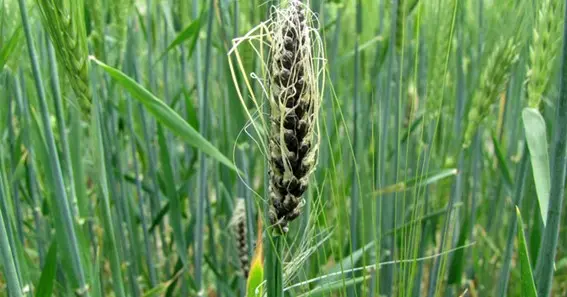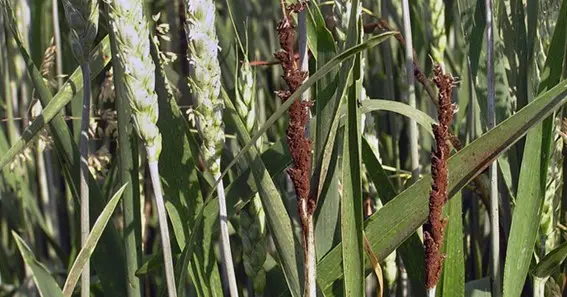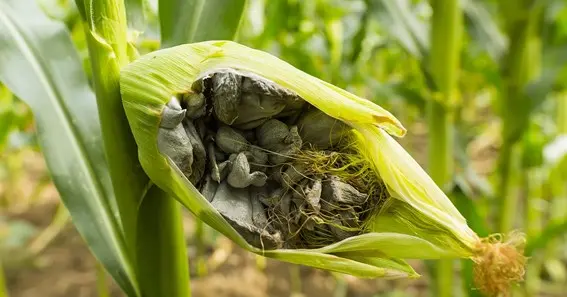What is Smut? Smut is a complex fungus that is known for having a lot of teliospores. They make many dark, thick-walled teliospores. Smuts are essential plant pathogens because they hurt grain crops and grasses the most, which costs money and changes how farming is done. Let’s learn more about what is smut.
What Is Smut?

Smut is a multicellular fungi with several teliospores. There are many different kinds of smut fungi, and they mostly hurt plants, especially grasses (Poaceae) and sedges (Cyperaceae). The teliospores of these fungi are big, black, and have thick walls. They give them a dirty look and are very important to their reproduction cycle. Smuts have a complicated life cycle that includes sexual reproduction.
Two haploid cells join together to make dikaryotic hyphae to attack host plants. When these fungi infect plants, they take over their reproductive systems and make galls. These galls finally burst, releasing spores that spread the infection. Smuts can damage crops like corn, barley, wheat, oats, sugarcane, and forage grasses, which are critical to the economy. Understanding smut fungi is essential to controlling and stopping the diseases they cause in crucial crops.
How Can Different Smut Be Controlled Based On Their Behaviour?

Smuts are fungi that infect many different plants and cause serious farming diseases. These pathogens often attack grasses and cereal crops, meaning essential products like maize, barley, and sugarcane lose money. Even though some smut fungi are harmful, they have unique relationships with their hosts, giving them perks they didn’t expect. It is essential to understand how smuts behave and how to control them To lessen their effect on farmland.
Hosts
These pathogens, called smuts, can affect many plant species, including monocot and dicot plants. Their main targets are cereal crops and other essential plants, such as maize, barley, wheat, oats, and sugarcane. These fungi do well by getting into the reproductive parts of the plants they infect. This stops the plants from making seeds and helps the disease spread through their teliospores.
Wild Rice Smut
Ustilago esculenta is an interesting species because it only affects Manchurian wild rice (Zizania latifolia). Unlike some other smuts, this one is good for farming in Asia because it makes rice stems grow more significantly, making them tasty and popular as a veggie. The swollen stems are picked for their crunchy texture and bamboo shoot-like flavor. In China, they are called “jiāo sǦn,” and in Japan, they are called “makomotake.” This shows that the fungus and the crop have a mutually beneficial relationship.
Sugarcane Smut
Sugarcane fields are in significant danger because of sugarcane smut caused by Sporisorium scitamineum. The “smut-whip,” a black, curved structure that emerges from the leaf whorl, is a sign of the disease. Because this fungus proliferates, primarily through water, during irrigation, taking precautions like treating plants with fungicides is essential. Infected crops have lower yields, which causes significant economic losses in sugar-growing areas.
Corn Smut
The fungus Ustilago maydis, also known as maize smut, affects maize and is seen differently in different countries. In Mexico, it’s a treat called huitlacoche, and people love it because it tastes rich and earthy and has a lot of protein. In some parts of the world, though, it’s seen as a bothersome bug. In maize smut, the kernels are replaced with fungal tissues, which are collected and used in various dishes. This is an exciting example of a pathogen being turned into a food source.
Conclusion
In the above stuff, we discussed what is smut. While smuts are interesting, they are also very harmful fungi that significantly affect farming. Spits show how complicated plant-fungal interactions can be. Fungi phylum Basidiomycota and, called Ustilaginomycetes, get their name from the Germanic word for “dirt” because they look like dust. They can hurt essential crops like maize and sugarcane or work with crops like Manchurian wild rice to help each other. To effectively handle smut fungi, you need to know about their lifecycle, the hosts they like, and the conditions that allow them to spread. It is possible to lessen the damage that smuts do to crops and keep them safe by using fungicides and managing watering well. Now you know what is smut.
FAQ
What Are Smut Fungi?
Smut fungi are plant pests that make dark teliospores with thick walls. They are only good for business if they infect many plants, primarily grasses and grains.
How Do Smut Fungi Get Into Plants?
Smut fungi take over the reproductive systems of the plants they live on and make galls that burst to release spores. These spores then attack plants nearby, which starts a new cycle of infection.
Can Smut Fungi Be Good For You?
Sometimes, like when Ustilago esculenta infects Manchurian wild rice, the fungus swells the stems, making a tasty veggie called “jiāo sǏn” or “makomotake.”
What Can Be Done To Stop Sugarcane Smut?
One can use Fungicides to get rid of sugarcane smut. The sugarcane can be soaked in the fungicide before planting or sprayed after planting. Using preventative watering methods is another way to help stop the spread.
Is Maize Smut Terrible For You?
Many places think of maize smut as a pest, but it’s a tasty treat called huitlacoche in Mexico. It was picked because it has a unique flavor and a lot of protein, and it is used in many traditional recipes.
What Are Some Simple Tricks To Manage Smut?
Tricks to manage smut
- Balanced Fertile Soil
- No injuries to the plant
- Protect from insects
- Choose well-adapted hybrids
Here are some interesting topics What is Lox Food?
Sources:
https://en.wikipedia.org/wiki/Smut_(fungus)
We have covered all the below topics in the above article
Smut fungus
Fungal disease
Plant pathology
Agricultural pests








